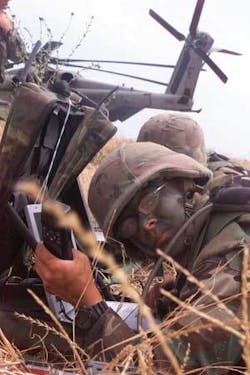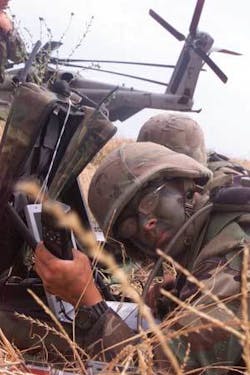EDS forms team for Air Force Space Command Communications Services
By John McHale
COLORADO SPRINGS, Colo. - EDS in Herndon, Va., is teaming with AT&T and other information technology providers in a bid for the Uniform Communications (Uni-Comm) program, an eight-year communications services contract to provide one unified communications network serving 40,000 personnel of U.S. Air Force Space Command.
EDS will act as the prime systems integrator with AT&T providing information architecture and security support and global communications services provider insights. RSIS and ManTech will provide communications operations and management services along with ITT Corp., which will also provide transformational architectures support. EDS officials made the announcement at SpaceComm 2007 in Colorado Springs, Col., in January.
This will “help Air Force Space Command develop and successfully implement a secure, interoperable network that will offer better flexible and highly efficient communications services, increasing space command readiness,” says Scott Worthington, EDS Uni-Comm program manager.
A net-centric logistics capability enables soldiers and sailors and their commanders to refocus their workflow and manual intervention away from recurring, tactical activities and more toward prevention and strategic activities, says Robert Cunningham, executive director, U.S. Government Solutions, advanced programs at EDS.
EDS engineers are not new to this type of enterprise having led the effort to integrate the largest government network in the world, the Navy Marine Corps Intranet (NMCI), as well as similar services contracts with the Department of Housing and Urban Development; a U.S. law enforcement agency; and the United Kingdom Ministry of Defense (MOD). EDS delivers global connectivity to 3.2 million desktops around the world through 13 service management centers and 57 service delivery centers for this program.
Some 500,000 active servicemen and women use NMCI, Cunningham says. There are more than 326,000 seats under EDS management-one seat, such as a workstation or laptop, can support more than one user.
The program helps the Navy and Marine Corps enhance network security, ensure interoperability across commands and with other services, facilitate knowledge-sharing around the globe, increase productivity, improve systems reliability and the quality of services, and reduce the cost of voice, video, and data services, EDS officials say.
NMCI and EDS operate four network operations centers, three Enterprise Help Desks, 16 (of 19 planned) classified server farms, 31 unclassified servers farms, 3,000 Enterprise-wide servers, and connectivity for approximately 11,000 Blackberry wireless devices and 2,086 air cards, 24 hours a day, seven days a week.
The big factor when integrating this type of infrastructure is change management, Cunningham says. It takes a lot of culture change in terms of trusting the new technology and “we employ change management” from the admiral or general all the way down to the average airman or sailor, he adds.
Cunningham says his team also takes great care to advertise to their customers that they are there if they need them, that they should not hesitate to call their 1-800 help number.
EDS even has a change-management simulation system, so customers can practice implanting new server farms, etc., Cunningham says.
Security is also an important element and is addressed, Cunningham says. For example NMCI is the only network to have completely implemented and enforced the Department of Defense’s Cryptographic Log-On (CLO) mandate, providing additional defense in depth.
The NMCI system blocks approximately 9 million spam messages per month and detects more than 5.2 million monthly unauthorized intrusion attempts to penetrate the NMCI external boundaries.
The EDS work for the MOD, the Defense Information Infrastructure (Future) (DII(F)) project will replace numerous individual information systems throughout the MOD with one, more efficient information infrastructure, EDS officials say. It will also enable many of the defense efficiency measures under the United Kingdom Defense Change Program to be achieved. These include network enabled capability-the ability to improve the capability of the armed forces through one network of information-announced in the United Kingdom Defense White Paper.
The MOD project is a 10-year contract awarded in 2005 to the ATLAS Consortium, led by EDS and made up of tier 1 partner Fujitsu Services, and key subcontractors General Dynamics, EADS Defense and Security Systems, and LogicaCMG.
The EDS Uni-Comm team has saved their government clients millions of dollars providing managed services in network-centric environments and was formed based on core competencies to best address Air Force Space Command’s security, connectivity, and service level priorities, Cunningham says.
Small business partners for the Air Force program include Bay Systems, GovWorks, INTECON, Keta Group, Knowledge Equity Partners, The Rader Network, Redman Consulting Services, and Telos. In addition, EDS has brought into play its Agility Alliance partners: Cisco, Microsoft, Xerox, EMC, Dell, and Sun.

